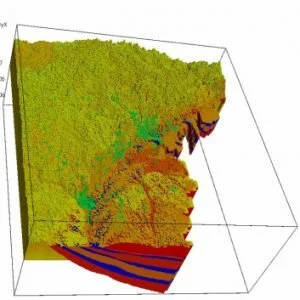UNTANGLING THE EFFECTS OF URBAN DEVELOPMENT ON SUBSURFACE STORAGE IN BALTIMORE
Previous studies of the influence of urban development on subsurface storage have not revealed any consistent pattern, with results showing increases, decreases, and negligible change in groundwater levels. We investigated the effects of four key features that impact subsurface storage in urban landscapes. These include reduced vegetative cover, impervious surface cover, infiltration and inflow (I&I) of groundwater and stormwater into wastewater pipes, and other anthropogenic recharge and discharge fluxes including water supply pipe leakage and well and reservoir withdrawals. We applied the integrated groundwater-surface water-land surface model ParFlow.CLM to the Baltimore metropolitan area. ParFlow is run using 324 processors using XSEDE (Extreme Science and Engineering Discovery Environment) resources. This work is part of a NSF Coupled Human-Natural Systems project investigating the feedbacks between water availability and development.
Bhaskar, A.S., C. Welty, R.M. Maxwell, A.J. Miller (2015), Untangling the effects of urban development on subsurface storage in Baltimore, Water Resources Research, doi: 10.1002/2014WR016039.
Bhaskar, A.S. 2010. Getting Started with ParFlow: Dead Run, Baltimore, Maryland Example. UMBC/CUERE Technical Report 2010/002. University of Maryland Baltimore County, Center for Urban Environmental Research and Education, Baltimore, MD. (zip for included files)
Notes from 28 June 2017 from Ben Choat on Deadrun Tutorial: Generating a solid file Troubleshooting
Executing ‘gfortran pf_solid_file_create.f90’ generated a file named ‘a.out’. On executing ‘a.out’ as ‘./a.out’ the following error was generated: “Program received signal SIGSEGV: Segmentation fault – invalid memory reference.”
To fix the problem two items were edited within the ‘pf_solid_file_create.f90’ file:
Line 41 was commented out using “!” before the line:
!bottom_elev = 0.0 ! elevation of the bottom of the domain (bottom of the aquifer)Line 96 was edited to replace “bottom_elev” with “0.0” which is the defined bottom elevation:
From
points(jj,3) = bottom_elev(i,j)To
points(jj,3) = 0.0After these edits were made the fortran code ‘pf_solid_file_create.f90’ was executed again to create a new a.out file. Executing the new a.out file generated the .pfsol file as expected.
There is a short addendum for ParFlow.CLM: parflow_with_clm.zip
Bhaskar, A.S., C. Jantz, C. Welty, S.A. Drzyzga, and A.J. Miller (2016), Coupling of the Water Cycle with Patterns of Urban Growth in the Baltimore Metropolitan Region, United States, Journal of the American Water Resources Association (JAWRA), 1–15, doi: 10.1111/1752-1688.12479.

